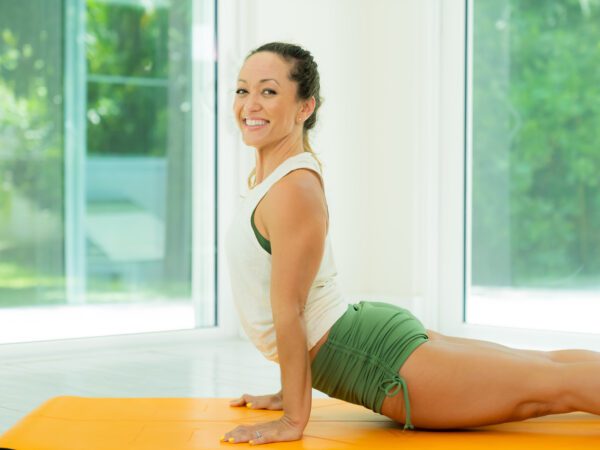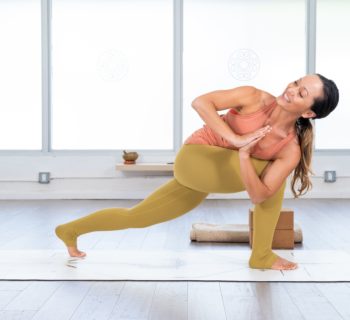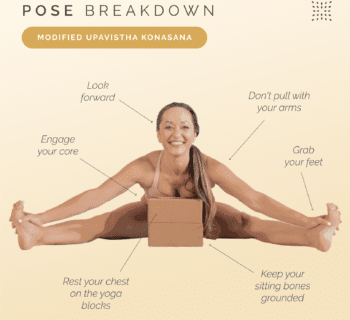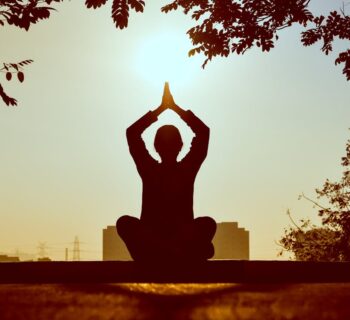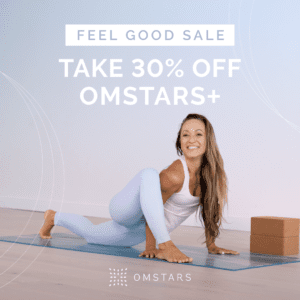Over 36 million Americans practice yoga, a testament to its profound impact on enhancing physical and mental well-being.
Starting a home yoga routine offers many benefits. Yoga builds strength and flexibility. Practicing at home is convenient and eliminates some of the barriers people experience when starting a new exercise routine. You don’t need to go to the gym. You can just open a browser and do a simple 15-minute practice when you have a few minutes to spare.
At the end of this post, you’ll find a simple 10 minute yoga class that is perfect for beginners.
Unlock the Power of At-Home Yoga
Embracing an at-home practice is an act of self-care. When you practice at home you aren’t restricted by schedules and spaces.
The practice becomes an anchor, a steady presence that grows alongside you, morphing into a “personal retreat.” There’s no need to conform to the rhythm of a class—your home practice blossoms at your own pace, echoing the individuality of your path. In these moments, the transformation of space and self align, and you find a unique clarity that only a tailored personal practice can offer.
Flexibility at Your Fingertips
Embracing a home yoga practice means flexibility is always within reach, quite literally and figuratively. No longer is there a need to fit into fixed class schedules; your session starts when you’re ready, in the privacy of your home.
The simplicity of rolling out a mat in your living space turns moments of stillness into opportunities for growth and self-discovery.
At-home yoga transforms any corner into a space for tranquility and physical harmony.
With a wide variety of online resources tailored to beginners, yoga has never been more accessible. From calming breathwork to foundational postures, your personalized journey toward wellness awaits at the tips of your fingers. Start where you are, use what you have, and embrace the flow at your own pace. As you grow and become more familiar with yoga, you can freely update your practice.
Self-Paced Progress
Home practice offers the invaluable gift of progressing on your terms, observing your body’s responses without haste.
Set Personal Intentions – Define your goals and tailor your practice to meet them.
Listen to Your Body – Honor your limits and embrace modifications for comfort and safety.
Consistency Over Intensity – Prioritize regular practice over pushing too hard, too fast.
Reflect and Adjust – Take time to reflect on your practice and adjust as needed for continuous progress.
Celebrate Every Milestone – Acknowledge each achievement, no matter how small, to fuel your yoga journey.
By flowing at your own pace, you’re more likely to develop a sustainable, long-term practice.
Equally, this personalized approach reveals the true beauty of yoga—its adaptability to your evolving needs and abilities.
Essential Yoga Gear for Beginners
Embarking on a yoga journey at home necessitates a few fundamental tools to craft a space that’s both comfortable and conducive to practice.
You don’t have to have these things to start your practice, but most people find them helpful.
Yoga mat – Yoga mats are useful because their grippy surfaces prevent you from sliding around in certain yoga poses. You don’t have to have one to practice though. Just be mindful of slipping.
Yoga blocks and straps – These tools can be used to aid in alignment and achieve deeper stretches. You can use a belt in place of a strap and thick books in place of yoga blocks.
Comfortable attire – You don’t need to buy yoga clothes to practice, but you do need clothing that allows for unrestricted movement.
Bolster or cushion – Bolsters and cushions are especially useful when for yin yoga practices, meditation, and breathwork.
Choosing the Right Mat
Your yoga mat is a foundational tool that supports your practice and posture throughout.
Choose a mat with adequate thickness for comfort and support.
Seek out non-slip textures to maintain stability in poses.
Consider eco-friendly materials to align with yogic principles of respect for the environment.
Look for mats that are easy to clean and maintain for long-term use.
Ensure the mat is long enough so you can practice without constraints.
Portability matters if you plan to join outdoor classes or yoga retreats.
A mat that aligns with your values and comfort needs enhances the experience.
Supportive Accessories
Consider yoga blocks a yogi’s best friend. These sturdy supports can aid in alignment and stability for various poses, allowing you to access poses safely and deepen your practice. Typically made from foam, cork, or wood, blocks can be altered in position to provide just the right level of support where you need it.
Blocks aren’t the only supportive allies.
Don’t overlook the value of yoga straps. A durable cotton or synthetic blend strap can help you reach limbs you can’t quite grasp on your own, aiding in stretching and maintaining alignment. It’s a simple tool with a powerful impact on enhancing flexibility and enabling proper pose execution.
Even blankets can elevate your practice. Yoga blankets offer versatile use, from adding cushioning under your knees or hips to supporting your neck during Savasana. These accessories are not just for comfort; they are strategically designed to assist in therapeutic positions and to maintain the integrity of your alignment.
Straps, blankets, and blocks are beginner essentials. These tools assist in accessibility, allowing you to safely explore your practice with support and confidence.
Maximizing Your Yoga Flow
Let consistency become your mantra; regularity turns sporadic practice into a transformative personal ritual. You don’t have to do a vinyasa or pranayama practice everyday, but making a goal to take time to practice several times a week is a good way to get started.
Seamless Transition Tips
As you cultivate your home practice, fluency between asanas is vital. This fluidity enhances not only the physical experience but also your mental resilience, creating a meditation in motion. It’s akin to a dance where each movement gracefully gives way to the next.
Focus on your breath’s natural rhythm to guide transitions. Inhale to expand and create space; exhale to move and flow into your next pose with ease.
Visually anticipate your next asana as you complete the current one, mentally preparing your body for the movement (rehearsing the transitions mentally can do wonders for your flow).
Anchor your gaze on a non-moving point, or drishti, to maintain balance and concentration during poses and when moving from one to another, especially when shifting weight.
Ingrain the habit of listening to your body as you transition, respecting its limits, and employing modifications if needed. This mindfulness prevents injury and ensures your practice grows in harmony to your individual needs and abilities.
Remember, perfection is not the goal; it’s about the journey. Small missteps are part of the process. Acknowledge them, learn, and continue to flow with grace and patience.
Mindfulness in Movement
Yoga is the embodiment of deliberate, mindful motion. In each flow, let your consciousness saturate every stretch and hold, marking it with the intention of presence and awareness. Attention to the subtleties of movement enriches your yoga journey exponentially, as you begin to notice the nuanced shifts in your body and breath.
Flowing through asanas requires a gentle focus, akin to a meditation in motion. This concentration fosters a deeper connection between mind, body, and breath, integral elements of your practice.
As we embody mindfulness in movement, we notice the interplay of muscles and breath, the push and pull of opposing forces working in harmony. This awareness encourages a seamless transition from pose to pose, cultivating a flow that is not just physical but deeply rooted in mindful connection.
Engaging in mindful movement within your yoga practice is like nurturing a conversation between your inner self and your physical form. Each inhalation and exhalation prompts a dialogue that guides your flow, ensuring a union of thought and action. As we move with mindfulness, this practice becomes a sanctuary for the self—a retreat where the confluence of breath, consciousness, and physicality leads to holistic wellness and inner tranquility.
Here is a short practice you can use to get you started.
Join Omstars to get instant access to yoga classes, guided meditation, and more. Download our app to have all of that on your phone whenever you need it. Get started today.
Photo by cottonbro studio: https://www.pexels.com/photo/woman-girl-morning-sport-4056536/



